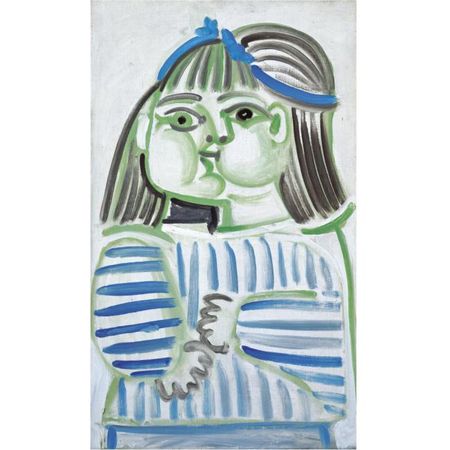Pablo Picasso (1881 - 1973), Buste de jeune fille (Paloma)
Pablo Picasso (1881 - 1973), Buste de jeune fille (Paloma)
Painted in Vallauris on January 7, 1951. Dated 7.1.51 on the reverse. Oil on canvas. 54.6 by 33 cm. Est. 900,000—1,200,000 USD
Claude Picasso has confirmed the authenticity of this work.
Maya Widmaier-Picasso has confirmed the authenticity of this work.
PROVENANCE; Estate of the artist
Private Collection, France
Thomas Ammann Fine Art, Zürich
Acquired from the above by the present owner
NOTE: This endearing portrait of Picasso's daughter Paloma was completed a few months before her second birthday in 1951. Buste de jeune femme (Paloma) is one of several oil versions that Picasso painted of his youngest child and marks the advent of an important new stage in his artistic development. Beginning in 1949 and continuing throughout the early 1950s, Picasso completed a series of portraits of Paloma and her older brother Claude in their nursery. These pictures are characterized by a linear simplicity that calls to mind the naiveté of childhood, and they can also be seen as direct responses to the 'playful' cut-outs that occupied Picasso's arch-rival Matisse around the same time. But the deceptively simple formalism of these pictures is counter-balanced by a powerful subjectivity that was rarely seen in 20th century portraits of children.
Paloma's arrival in April 1949, two years after the birth of her brother Claude in May 1947, marked a new period of creativity at this advanced stage in Picasso's life. As Michael FitzGerald writes, "Unlike earlier pictures of his first son Paulo (born in 1921), which generally present the youngster in a formal pose and fancy dress, and the more uninhibited portrait of Maya (born in 1935), the images of Claude and Paloma reflect Picasso's joyful immersion in their world, and a liberation from adult expectations.... Having brought us into sympathy with the child's universe, Picasso then immerses us into their world by inverting an old canard against modern art. He took the conventional dismissal of non-naturalistic styles as "something a child could do" and employed it to project the perceptions of a youngster not yet adjusted to his or her own body, or certain of how to navigate the outside world" (M.C. FitzGerald, "A Triangle of Ambitions: Art, Politics and Family during the Postwar Years with Françoise Gilot" Picasso and Portraiture: Representation and Transformation (exhibition catalogue), The Museum of Modern Art, New York & Grand Palais, Paris, 1996-97, p. 430).
Sotheby's. Impressionist & Modern Art Evening Sale. 05 May 09. New York www.sothebys.com Photo courtesy Sotheby's

/https%3A%2F%2Fprofilepics.canalblog.com%2Fprofilepics%2F1%2F0%2F100183.jpg)
/https%3A%2F%2Fstorage.canalblog.com%2F03%2F02%2F119589%2F96711876_o.jpg)
/https%3A%2F%2Fstorage.canalblog.com%2F11%2F31%2F119589%2F94773502_o.jpg)
/https%3A%2F%2Fstorage.canalblog.com%2F20%2F83%2F119589%2F94772815_o.jpg)
/https%3A%2F%2Fstorage.canalblog.com%2F26%2F72%2F119589%2F75604929_o.jpg)
/https%3A%2F%2Fstorage.canalblog.com%2F59%2F60%2F119589%2F26458628_o.jpg)



/http%3A%2F%2Fstorage.canalblog.com%2F25%2F77%2F119589%2F129711337_o.jpg)
/http%3A%2F%2Fstorage.canalblog.com%2F60%2F34%2F119589%2F128961949_o.png)
/http%3A%2F%2Fstorage.canalblog.com%2F84%2F21%2F119589%2F128701730_o.jpg)
/http%3A%2F%2Fstorage.canalblog.com%2F96%2F14%2F119589%2F128351398_o.jpg)